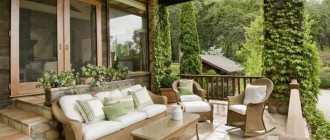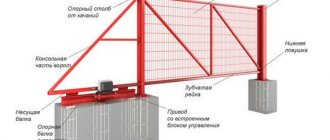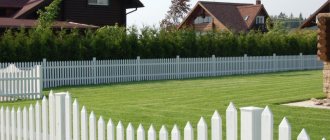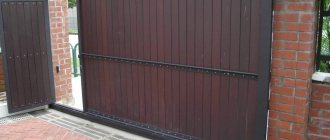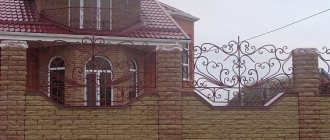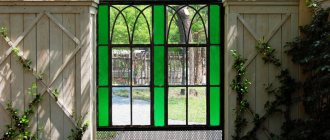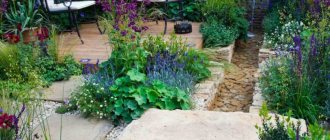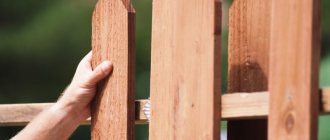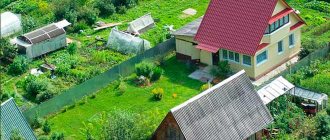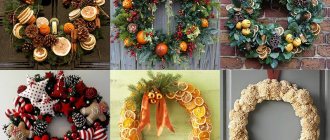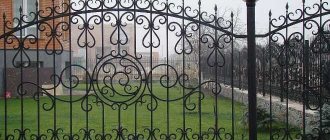As soon as a person begins to build his own house, he first of all thinks about how to protect himself from all sorts of troubles (from uninvited guests to inquisitive glances).
To achieve this goal, he thinks about what kind of fence he should put up. After all, this design should not be strictly limited to protective functions; it may well act as an auxiliary element of the decor of the estate.
And if a person decides to choose a universal option for himself, then a wrought-iron fence for a private house is exactly what he needs.
Preparation
Before starting such a large and ambitious project, you should familiarize yourself in more detail with all the proposals that companies for the construction of these structures can offer. In order to find them, you don’t have to go to every store and check all the details.
Using the World Wide Web, you can find information, photos of forged fences, and any other information related to this product. The main thing is to correctly analyze the market and choose exactly the product that is most suitable.
Gates and their types
Forged gates and gates are elements of landscape design. Regardless of the type of fence, they are able to independently decorate any area. Skilled craftsmen transform the entrance to the courtyard into a work of art. The pattern of the gate can repeat the pattern on the fence and represent a single whole with the entire fence. If there are no complex details on the fence fabric, the gate acts as an independent decorative element.
General compatibility of fence and gate elements
They can be made using complex forging techniques and consist of unique designs. For such gates, designers create individual sketches taking into account the architectural style of the house and the taste of the owner.
According to the method of opening gates there are:
- recoil;
- swing
Sliding wrought iron gates consist of one leaf. The design is based on a reinforced frame made from a large section profile. Rollers and a drive are attached to the lower beam. To make the canvas, sketches with the simplest execution of forged elements and masterpieces of blacksmith art are used. The canvas can be transparent and combined with various materials.
Sliding design of the entrance group
Sliding gates do not need free space in front of the entrance to the yard, this is their advantage. The disadvantage is that iron structures are heavy, they require a reinforced frame and a strong strip for sliding the rollers.
Swing gates are most often a double-leaf design. The sashes are symmetrical relative to the axis along the connection line. Metal structures require massive, durable hinges on which the openwork fabric will hang. Often, for strength, they make 3 pairs of canopies on each gate leaf.
Wickets can be installed separately and mounted in one of the gate leaves. In the album with photographs you can see that the design of the gate repeats the pattern on the gate or represents the most interesting fragment of the sketch.
Integrating a wicket into a gate allows you to save space and material
Manufacturing technology
Gates of this type are made from various types of metal, using the most advanced innovations. In this case, a technology is used that makes the metal elastic.
When the process of forging a product begins, a metal blank (a rod is most often used for fences) is heated and brought to the desired temperature environment. Then, using pressing, they give it any shape that the customer needs.
In this case, the forms can take on an absolutely unique look, since at this moment the hot metal material becomes very plastic, which allows decorative and twisted patterns to be cast from it.
As soon as the required amount of finished products is collected, they are combined into so-called sections through mechanical influences. After which these sections are attached to specially installed support pillars.
Considering the fact that the work is carried out with a soft metal base, the craftsmen manage to combine decorative patterns into one with virtually no seams. That is why beautiful wrought iron fences look very attractive compared to other analogues.
Metal products
It is worth mentioning that forging elements, without a doubt, give any territory equipped with them a certain reliability and fundamentality.
At the same time, forging can not only fascinate with its metallic power, but also evoke real admiration for its unique designer elements, striking in sophistication and subtlety. But to truly appreciate the fundamental beauty of metal, you have to really get into it.
Manufacturing of forged elements
Creating steel masterpieces is possible in several ways:
- Stamping is the least energy-intensive method in terms of the use of physical force. This is a mechanized, production process. Elements produced in this way will cost you significantly less than those created directly by the hands of a blacksmith.
- Hand forging is used by blacksmiths mainly to create unique things. Such products will cost you a lot, but in the end they will justify their price. After all, exclusive designer or your own fantasies embodied in metal will definitely become a source of pride for the owner.
Hand forging can be of two types:
- Hot - before using a hammer or the hands of a blacksmith, the metal becomes flexible and ductile, heating up red-hot in the mining process.
- Cold - in its process, the metal takes the necessary shape thanks to the physical strength and skill of the blacksmith, as well as available (mostly) devices.
Forging an element using cold forging is physically more difficult for a blacksmith.
Purchase
Where to buy a wrought iron fence? The question is of course rhetorical, but the answer is quite simple. Products for this purpose can be purchased either in a construction supermarket on order, or directly through a plant or factory that is directly involved in metal casting or is associated with it.
In any case, both there and there the person will be helped to do what he wants to get. The only difference is finances.
What is a front garden
The main decoration of the plots are flowers and green ornamental vegetation. For planting, special places are allocated where flower beds are laid out. One of them is a piece of land in front of the building. The visible place is called the front garden. The most beautiful flowers are always planted here. The front garden acts as the face of the yard, which means that special fencing is also required. An excellent option is a beautiful wrought-iron front garden, painted black, bronze or silver.
The fence protects the area from the entry of uninvited guests, and at the same time does not obstruct the view of growing ornamental plantings. Depending on various factors, the height of forged front gardens has a wide range. There are low fences of about 30 cm, as well as large three-meter fences. The structure consists of metal spans supported by supports. Due to the impressive weight of forged front gardens, the distance between the pillars is small. The parameter depends on the height of the fence. Additionally, the density of the location of metal elements along the span and their thickness are taken into account.
Important! For stability, the supports of forged fences are concreted. High fences have a foundation.
There are four important requirements for fencing a front garden:
- ensuring reliable protection of the site from uninvited guests;
- attracting attention to the design of the front garden and growing flowers;
- harmonious combination with the architectural ensemble;
- providing safe access to the front garden to the owners of the site.
A variety of forged fences allows you to beautifully decorate the front garden of any private yard.
Preparatory work
In order for the installation of gates (this is the most complex element of the fence structure) to be successful, several facts should be taken into account:
- if the gate will open inward, the necessary free space in the yard should be provided;
- when opening from the outside, the doors should not block the movement of vehicles and pedestrians;
- To prevent the doors from moving due to gusts of wind, it is necessary to provide a device for fixing them.
If these conditions cannot be met, you should consider another design, for example, a sliding one. After choosing the type of gate, you need to start creating a project for the entire forged fence. To do this you will need to perform a number of actions:
- choice of material;
- calculation of needs in accordance with the type and size of the profile;
- drawing up a bill of materials and assessing possible costs for the manufacture and installation of the structure.
If you are satisfied with the cost of the fence, then you can begin the main work.
How to build a forged front garden with your own hands
At first glance, installing a wrought iron fence seems like a small thing. The myth is debunked with the start of work. First, you need to consider a commercially available example of a forged front garden and choose the appropriate option.
There are three options for fences:
- Standard products are spans where forging elements are made according to ready-made templates. Fences are budget-friendly.
- Spans made of decorative forging are the most expensive. Each element is made according to an exclusive sketch and has no repetitions.
- Combined front gardens are a mixture of a standard product with decorative forging. The owner buys template spans and, to make them unique, orders the insertion of one or more exclusive elements.
Of all the options, the third type of front garden is most often in demand by owners of private courtyards.
Drawings, sketches and measurements
An important stage in the construction of a front garden is the preparatory period. When choosing sketches of forged front gardens from photos, they simultaneously try to answer three questions:
- is it needed in front of the house;
- what functions will it perform;
- what its appearance will be.
The first step is to visualize the object. First, they create a front garden in their imagination and think through the nuances. When the overall picture is clear, we begin to take measurements. Construction cord and stakes mark the outline of the fence. Use a tape measure to measure the dimensions of the fence. Count the number of spans and supports.
If you plan to order decorative forging, then photos of forged front gardens in front of a private house as an example will play a secondary role. You will have to create the sketches yourself. You can seek help from specialists involved in the manufacture of metal structures.
Advice! Sketches of the fence need to be carefully thought out from the very beginning. In the future, changing the appearance of the structure will be difficult and expensive.
Purchase of materials
Having accurate drawings in hand, where all dimensions, number of spans, supports are indicated, we begin to purchase materials. Template metal structures are purchased ready-made. To create an exclusive forging, they look for an organization and place an order.
In addition to metal structures, cement, sand, and crushed stone are needed for concreting pillars. If you plan to build a base with stone supports, buy bricks, blocks or boulders. The foundation will need reinforcement to create a reinforcing frame.
Construction
The main job is to securely install the supports. The stability of the spans depends on this. Depending on the size and weight of the fence, choose the appropriate method:
- Metal supports are simply concreted into the ground. First, a hole is drilled for each post. A 20 cm layer of crushed stone is poured onto the bottom. All supports are leveled. Measure the distance between them again so that the span fits correctly. If everything is fine, the holes are compacted with stones and filled with liquid concrete.
- Metal supports are placed on the foundation. This option is in demand for large, heavy fences. Here too there are two ways. The support can be secured to a ready-made foundation with anchors or welded to a steel embedded plate. According to the second method, the support is embedded in the concrete base at the stage of its pouring.
When forged spans are supposed to be installed between stone or brick supports, metal pillars are still installed first. Stone or brick is laid around them in mortar. An embedded plate is embedded inside the masonry, to which a forged span will be welded in the future.
The foundation for the fence is made in the form of a concrete strip. First they dig a ditch. The depth depends on the mass of the fence and the level of soil freezing in the region. The bottom of the trench is covered with sand and gravel, the walls are covered with roofing felt. Formwork is made from boards. A frame in the form of a box, connected from reinforcement, is laid inside the trench. If the racks are to be concreted, then the pipes or profile are installed in the drilled holes. The racks are welded with rods to the reinforcing frame.
Concrete pouring is carried out in one day. A month is allowed for complete hardening. When the foundation gains strength, forged spans are welded or bolted to the supports. The final stage of construction is painting. Usually the forging is painted black, silver or bronze.
Schemes and drawings of finished structures in different styles
To create the desired fence, it is recommended to think through a sketch or sample in advance. In this case, the wishes of the customer must be taken into account.
Fences are made in different styles. Here are the main ones:
- Russian. Convex parts are used. Natural, natural motifs predominate;
- Russian-Byzantine. Has similar features to the previous style. Characterized by the presence of geometric shapes;
- Baroque. Small patterns predominate: flowers, crowns, ornaments, baskets. The fence looks luxurious and elegant;
- Gothic. The fence looks elongated. Lancet designs are spectacular;
- Rococo. Similar to Baroque style. But it differs in a smaller number of small elements;
- Modern. Abstract details predominate.
Where is it used?
Forged elements are used to decorate the design of buildings and interiors.
They are often used for decoration:
- Stair structures;
- Flower gardens;
- Verandas;
- Palisadnikov;
- Terrace;
- Gazebo;
- Fencing;
- Canopies;
- Fence;
- Balconies;
- Mangalov;
- Swing;
- Interior items.
Forging looks good with parts made of wood, corrugated board, iron or polycarbonate. Therefore, you can safely combine several materials to make a fence.
